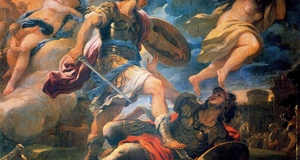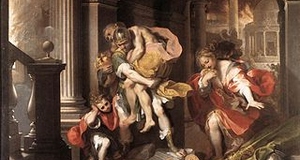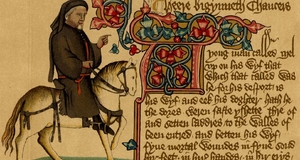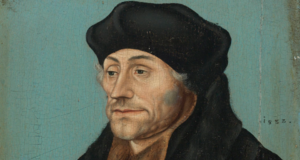Exploring Virgilian Structures in Book III of Spenser's Faerie Queene
By
2014, Vol. 6 No. 04 | pg. 2/2 | « Britomart and Aeneas: Errant HeroesA highly multifaceted parallel exists between Britomart and Aeneas himself. In addition to being the founders of empires, both Britomart and Aeneas are compelled by fate to undertake long journeys in pursuit of glorious ends. Canto iii parallels Aeneas’s encounter with his father, Anchises (Book VI). In these scenes, Britomart and Aeneas are recipients of a prophecy concerning the empires they will establish. This prophecy is the inspiring force that motivates both heroes to pursue their journeys to completion. Merlin’s prophecy that “renowmed kings, and sacred Emperours / Thy fruitfull Ofspring, shall from thee descend” and his decree that Artegall is “the man whom heavens have ordaynd to bee / The spouse of Britomart” compels her to become a knight in order to find Artegall (canto iii, s. 23-26). Pope asserts that “Merlin’s first speeches have convinced Britomart that she will find Arthegall, explained the nature and purpose of her love, and revealed that God has chosen this love for her” (53). Merlin’s words make her a slave to destiny. From that moment on, she relinquishes individualism to become a single gear in the machinations of fate. She begins to live for the fulfillment of the prophecy, becoming a knight in the process. Similarly, Anchises’ prophecy to Aeneas reveals the fates’ plan for him and lends him a specific purpose which drives him to the completion of his odyssey. Anchises reassures Aeneas that “the Trojan honor and the Roman boast/ [shall be] Admired when living and adored when lost” (Clarke 177, l. 876-877). Henceforth, Aeneas too sacrifices autonomy for the greater good. Unlike previous wanderings to Libya, where he longed to tarry for personal pleasure with Queen Dido, Aeneas is now bent on attaining Italy. His focus has shifted to the fulfillment of the fates’ plan for his race. Pope too notes the deviation of each story’s focus from the hero/heroine as an individual, and the importance placed on the divine forces which shape their lives. Anchises’ prophecy shows Aeneas that “service to Rome, not personal happiness, matters most” (Pope 67). Similarly, “Britomart [must] learn that obedience to God, not personal success, matters most” (Pope 67). Although they are the heroes of their respective stories, Britomart and Aeneas are subject to the whims of the fates. They must forge a path previously hewn for them by divine forces. This comparison projects the selflessness of both heroes. Britomart’s self-sacrifice may have served to create a feeling of obligation in Spenser’s English audience. Living in the shadow of so noble an ancestor, English readers’ responses may have included a desire to uphold Britomart’s moral standard. In this way, she served not just as a cog in the clockwork of history, but a model for behavior. This aligns with Spenser’s purpose in creating the patron knights. Merlin’s and Anchises’ prophecies both consist of a chronology of the heroes’ descendants, culminating in a “golden age” ruler. Merlin concludes that “a royall Virgin [Elizabeth I] [shall] raine, which shall/ Stretch her white rod ouer the Belgicke shore/ And the great Castle smite so sore with all/ That it shall make him shake, and shortly learn to fall” (s. 49). Anchises describes to Aeneas “Caesar himself, exalted in his line – / Augustus, promised oft and long foretold/ Sent to the realm that Saturn ruled of old/ Borne to restore a better age of gold” (Clarke 172-173, l. 790-792). However, both prophecies admit that the heroes’ descendants will also undergo hardship. Merlin mentions a point at which “the feeble Britons [will be] broken with long warre” and cries “woe, and woe, and everlasting woe/ Be to the Briton babe, that shalbe borne/ To live in thraldome of his fathers foe” (Hamilton 314, s. 23 & 42). Similarly, Anchises begs Aeneas, “Seek not to know…The sorrows of thy sons in future years” (Clarke 177, l. 868-869). As before, the Virgilian style of Merlin’s prophecy contributes to the epic style of canto iii.ConclusionParallels between Book III, canto iii of Spenser’s Faerie Queene and Virgil’s Aeneid infuse Spenser’s poem with the spirit of an epic which foretells a great British empire. Spenser’s stance in canto iii is decidedly imperialistic. He also glorifies his patron knight of chastity, Britomart, by comparing and contrasting her with Venus in the Aeneid. This comparison lends her a divine quality, but the differences between the two characters also portray Britomart as a virtuous character. Similarities between Britomart and Aeneas himself reveal how both characters are errant subjects of fate despite their status as “heroes.” Britomart’s sacrifice of her autonomy adds nobility to her list of virtues. The contribution of these features to the epic grandeur of the Faerie Queene reflect Spenser’s optimistic prediction of a rise in British political power during the Golden Age of Elizabeth I. This patriotic optimism is proportional to its historic context, given that the first three books of the Faerie Queene were published in 1590, close upon the heels of England’s defeat of the Spanish Armada under Philip II in 1588. Rich from Caribbean gold and sugarcane, with the power of the Catholic Church and the technological advantage of enormous galleons at its disposal, Spain’s loss to England in this battle was unprecedented. Despite the advent of storms which hindered the maneuverability of the galleons and aided the British, this victory marked the beginning of a British foothold on the imperial stage. It is interesting to note, retrospectively, that the predictions which this victory no doubt led Spenser to make in the Faerie Queene came to fruition within the next couple of centuries. Indeed, the day was not far off when the “sun would never set on the British Empire.” ReferencesBroaddus, J. W. (1995). Spenser's Allegory of Love: Social Vision in Books III, IV, and V of The Faerie Queene. Madison: Fairleigh Dickinson University Press. Cavanagh, S. T. (1994). Wanton Eyes and Chaste Desires: Female Sexuality in the Faerie Queene. Bloomington: Indiana University Press. Cheney, P. (1997). Marlowe's Counterfeit Profession: Ovid, Spenser, Counter-Nationhood. Toronto: University of Toronto Press. Clarke, H. (1989). Vergil's Aeneid. Toronto: University of Toronto Press. Cranch, C. (1872). The Aeneid of Virgil. Boston: James R. Osgood & Company. Douglas, G. (1513). Virgil's Aeneid Translated into Scottish Verse: by Gavin Douglas. Edinburgh: William Blackwood and Sons. Freeman, R. (1970). The Faerie Queene: A Companion for Readers. Berkeley: University of California Press. Halsall, P. (August 1997). Internet History Sourcebooks. Fordham University. Retrieved March 19, 2013, from http://www.fordham.edu/halsall/mod/1588elizabeth.asp Hamilton, A. C. (1990). The Spenser Encyclopedia. Toronto: University of Toronto Press. McManus, C. (2002). Spenser's Faerie Queene and the Reading of Women. Newark: University of Delaware Press. Pollock, Z. (1980). Concupiscence and Intemperance in the Bower of Bliss. Studies in English Literature, 20(1), 43-58. Pope, N. P. (1990). National History in the Heroic Poem: A Comparison of the Aeneid and the Faerie Queene. New York: Garland Publishing. Spenser, E., & Hamilton, A. C. (1977). The Faerie Queene (3d ed.). London: Longman. Thompson, J. (2001). The Character of Britomart in Spenser's The Faerie Queene. Lewiston, N.Y.: E. Mellen Press. Tonkin, H. (1989). The Faerie Queene. London: Unwin Hyman. Doren, M. V. (1946). The Noble Voice: A Study of Ten Great Poems. New York: Henry Holt & Co. Welcome: Spenser Online. (2013). Faculty of English: Cambridge University. Retrieved March 28, 2013, from http://www.english.cam.ac.uk/spenseronline/welcome/ Suggested Reading from Inquiries Journal
Inquiries Journal provides undergraduate and graduate students around the world a platform for the wide dissemination of academic work over a range of core disciplines. Representing the work of students from hundreds of institutions around the globe, Inquiries Journal's large database of academic articles is completely free. Learn more | Blog | Submit Latest in Literature |


















